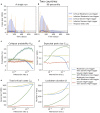Infection dynamics of COVID-19 virus under lockdown and reopening
- PMID: 35087091
- PMCID: PMC8795434
- DOI: 10.1038/s41598-022-05333-5
Infection dynamics of COVID-19 virus under lockdown and reopening
Abstract
Motivated by COVID-19, we develop and analyze a simple stochastic model for the spread of disease in human population. We track how the number of infected and critically ill people develops over time in order to estimate the demand that is imposed on the hospital system. To keep this demand under control, we consider a class of simple policies for slowing down and reopening society and we compare their efficiency in mitigating the spread of the virus from several different points of view. We find that in order to avoid overwhelming of the hospital system, a policy must impose a harsh lockdown or it must react swiftly (or both). While reacting swiftly is universally beneficial, being harsh pays off only when the country is patient about reopening and when the neighboring countries coordinate their mitigation efforts. Our work highlights the importance of acting decisively when closing down and the importance of patience and coordination between neighboring countries when reopening.
© 2022. The Author(s).
Conflict of interest statement
The authors declare no competing interests.
Figures




References
-
- Bernoulli D, Blower S. An attempt at a new analysis of the mortality caused by smallpox and of the advantages of inoculation to prevent it. Rev. Med. Virol. 2004;14:275–288. - PubMed
-
- Hamer WH. Epidemic Disease in England: The Evidence of Variability and of Persistency of Type. Bedford Press; 1906.
-
- Kermack WO, McKendrick AG. A contribution to the mathematical theory of epidemics. Proc. R. Soc. Lond. Ser. A Contain. Pap. Math. Phys. Character. 1927;115:700–721.
-
- Bailey NT, et al. The Mathematical Theory of Infectious Diseases and Its Applications. Charles Griffin & Company Ltd; 1975.
-
- Diekmann O, Heesterbeek JAP, Metz JA. On the definition and the computation of the basic reproduction ratio in models for infectious diseases in heterogeneous populations. J. Math. Biol. 1990;28:365–382. - PubMed
Publication types
MeSH terms
Grants and funding
LinkOut - more resources
Full Text Sources
Medical

